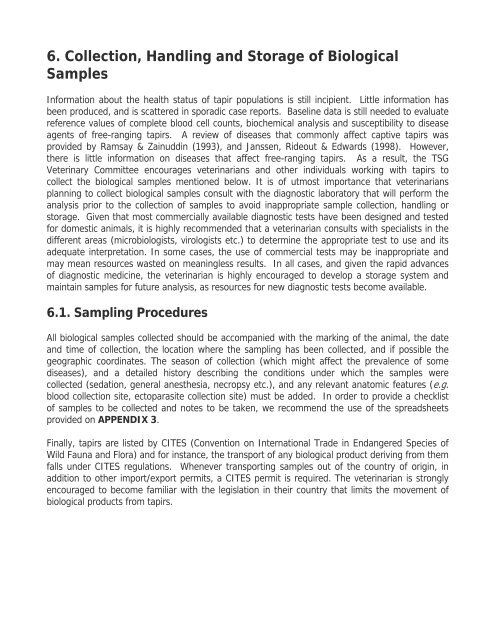TAPIR FIELD VETERINARY MANUAL - Tapir Specialist Group
TAPIR FIELD VETERINARY MANUAL - Tapir Specialist Group
TAPIR FIELD VETERINARY MANUAL - Tapir Specialist Group
You also want an ePaper? Increase the reach of your titles
YUMPU automatically turns print PDFs into web optimized ePapers that Google loves.
6. Collection, Handling and Storage of Biological<br />
Samples<br />
Information about the health status of tapir populations is still incipient. Little information has<br />
been produced, and is scattered in sporadic case reports. Baseline data is still needed to evaluate<br />
reference values of complete blood cell counts, biochemical analysis and susceptibility to disease<br />
agents of free-ranging tapirs. A review of diseases that commonly affect captive tapirs was<br />
provided by Ramsay & Zainuddin (1993), and Janssen, Rideout & Edwards (1998). However,<br />
there is little information on diseases that affect free-ranging tapirs. As a result, the TSG<br />
Veterinary Committee encourages veterinarians and other individuals working with tapirs to<br />
collect the biological samples mentioned below. It is of utmost importance that veterinarians<br />
planning to collect biological samples consult with the diagnostic laboratory that will perform the<br />
analysis prior to the collection of samples to avoid inappropriate sample collection, handling or<br />
storage. Given that most commercially available diagnostic tests have been designed and tested<br />
for domestic animals, it is highly recommended that a veterinarian consults with specialists in the<br />
different areas (microbiologists, virologists etc.) to determine the appropriate test to use and its<br />
adequate interpretation. In some cases, the use of commercial tests may be inappropriate and<br />
may mean resources wasted on meaningless results. In all cases, and given the rapid advances<br />
of diagnostic medicine, the veterinarian is highly encouraged to develop a storage system and<br />
maintain samples for future analysis, as resources for new diagnostic tests become available.<br />
6.1. Sampling Procedures<br />
All biological samples collected should be accompanied with the marking of the animal, the date<br />
and time of collection, the location where the sampling has been collected, and if possible the<br />
geographic coordinates. The season of collection (which might affect the prevalence of some<br />
diseases), and a detailed history describing the conditions under which the samples were<br />
collected (sedation, general anesthesia, necropsy etc.), and any relevant anatomic features (e.g.<br />
blood collection site, ectoparasite collection site) must be added. In order to provide a checklist<br />
of samples to be collected and notes to be taken, we recommend the use of the spreadsheets<br />
provided on APPENDIX 3.<br />
Finally, tapirs are listed by CITES (Convention on International Trade in Endangered Species of<br />
Wild Fauna and Flora) and for instance, the transport of any biological product deriving from them<br />
falls under CITES regulations. Whenever transporting samples out of the country of origin, in<br />
addition to other import/export permits, a CITES permit is required. The veterinarian is strongly<br />
encouraged to become familiar with the legislation in their country that limits the movement of<br />
biological products from tapirs.










